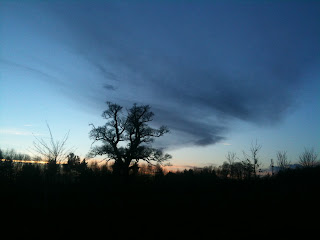One of the changes with going to work each day, is that I can no longer walk the dog whenever I feel like it. Popping out at lunchtime or in between rain showers has been replaced with a walk after dinner, in the dark, whatever the weather. This seems like a bit of a disadvantage in winter, when it is mainly cold, wet and very muddy.
Where daytime walks offer the opportunity for foraging, photos, ball throwing and chatting with other dog walkers, dark evening walks are....well dark....though somehow still very lovely.
To start with I tried my normal walk through the muddy woods, but slipping and sliding through the mud and tripping over roots that I couldn't see was downright dangerous. I could have taken a torch, but it only lights a short distance and spoils my night vision. After a spectacular fall off a wet slippery stile, I headed for more open spaces, where on a cloudy night or with the moon out, visibility is fair.
And now the cold crisp evenings are wonderful, and blissfully quiet with all the people tucked up in their cosy warm houses. Even rainy evenings are really not that bad, but the best are when the stars come out.
 |
| The bright stars at Orion's belt are easy to spot |
My knowledge of stars is rubbish, but I really wanted to know if what I thought was Orion's belt really was. So I got a stargazing app, and I'm loving it. Yes, if you ever see the silhouette of a woman stood out in the dark staring up at her mobile held above her head - it's me :-) Of course it is easier to just lay in bed and aim it at the ceiling and the app still shows you the stars, but I like standing alone on the hill overlooking all the twinkly lights from the town and feeling like a speck in this vast universe.
Another night-walk discovery is that all the trees have dog tags. On a windy night they jingle at you as you walk past. It did take me a while to realise that we were not being followed everywhere by a cat with a bell on its collar.
I have known for a while that the bigger, older trees, that maybe need protecting have numbered tags, and I am sure this must help to keep track of which tree is which, and find them when they get lost. But all the trees? Right down to the scrawny little things, that are more of a large shrub? Surely not!
If anyone knows the purpose then please do share it, as I am sure there must be some good intentions somewhere behind this madness? Is someone watching and recording all the trees being wiped out by climate change? Or maybe it is just part of the council's maintenance program? It just seems a waste to me. The time and money spent hammering tags into trees and recording them all, could surely have been better spent on planting new trees, to help our degraded landscape heal.
Next time you listen to the wind whispering through the trees, don't be surprised to find that they jingle now instead!


No comments:
Post a Comment